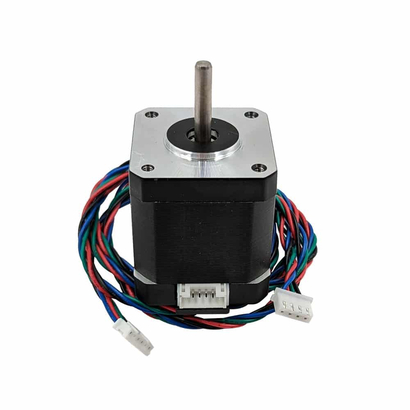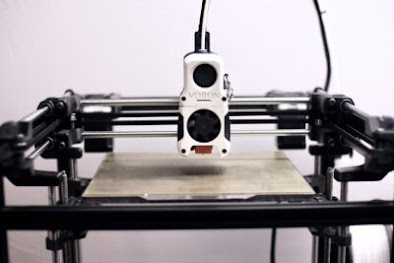Stepper Motors Basics: Types, Uses, and Working Principles
This article here talks about what stepper motors are and how they work. Learn about stepper motors, how they are used, and how they work. LDO stepper motor produces a variety of stepper motors, but their specialty is those used in 3D printers. Voron Trident 3D printer released.
What is Stepper Motor Basics?
A stepper motor is a type of electric motor in which the shaft rotates by a fixed number of degrees at regular intervals. This is possible because of how the engine is built on the inside. The exact angle of the shaft can be found by counting how many steps have been taken, so there is no need for a sensor. It can also be used for many different things because of this.
Stepper motor types
Permanent Magnet Stepper Motor:
In permanent magnet motors, the rotor contains both an electromagnet and a permanent magnet (PM). The permanent magnets (PM) inside the rotor are drawn to or repelled by the electromagnets in the stator.
Variable Reluctance Stepper Motor:
Motors with variable reluctance (VR) use the principle that the minimum reluctance occurs at the minimum gap and have a rotor composed of plain iron. The rotor's tips are attracted to the stator's magnet poles in this configuration.
What is Stepper Motor Basics?
A stepper motor is a type of electric motor in which the shaft rotates by a fixed number of degrees at regular intervals. This is possible because of how the engine is built on the inside. The exact angle of the shaft can be found by counting how many steps have been taken, so there is no need for a sensor. It can also be used for many different things because of this.
Stepper motor types
Permanent Magnet Stepper Motor:
In permanent magnet motors, the rotor contains both an electromagnet and a permanent magnet (PM). The permanent magnets (PM) inside the rotor are drawn to or repelled by the electromagnets in the stator.
Variable Reluctance Stepper Motor:
Motors with variable reluctance (VR) use the principle that the minimum reluctance occurs at the minimum gap and have a rotor composed of plain iron. The rotor's tips are attracted to the stator's magnet poles in this configuration.
Synchronous Hybrid Stepper Motor:
The name "hybrid" comes from the fact that hybrid stepper motors use both a permanent magnet (PM) and variable reluctance (VR) to get the most power out of a small size.
Stepper Motors Are Used For:
Commercial applications for stepper motors include optical disc drives, bright lights, camera lenses, CNC machines, 3D printers, and flatbed scanners.
Advantages:
1. The rotation angle is related to the number of pulses sent in.
2. Full torque at a standstill.
3. Getting a synchronous rotation going at a plodding speed is possible.
4. It is reliable because there are no brushes.
5. The speed is directly related to the number of pulses sent in. This means that a wide range of rotational speeds can be made.
6. Slow speed and great accuracy.
Working Principle:
Electromagnetism is the idea behind how a stepper motor works. The electromagnetism stators are all around the shaft of the magnetic rotor. Both the rotor and the stator have poles, which may or may not have teeth depending on the stator type. When the stator has given the rotor power, the rotor moves to line up with the stator. To turn the stepper motor, this is how the stators are turned on at different poles in order. These are very useful in industrial process control systems, CNC machines, robotics, manufacturing automation systems, and instrumentation because they can control speed, rotation, direction, and angle very well.
Conclusion:
So, this is a general look at the stepper motor, including its types, uses, how it works, and so on. Now you know about the different super engines and how they can be used. If you have any more questions, feel free to ask. LDO stepper motor is available in all sizes. Using voron trident build of Materials is in Voron Design's configurator.
The name "hybrid" comes from the fact that hybrid stepper motors use both a permanent magnet (PM) and variable reluctance (VR) to get the most power out of a small size.
Stepper Motors Are Used For:
Commercial applications for stepper motors include optical disc drives, bright lights, camera lenses, CNC machines, 3D printers, and flatbed scanners.
Advantages:
1. The rotation angle is related to the number of pulses sent in.
2. Full torque at a standstill.
3. Getting a synchronous rotation going at a plodding speed is possible.
4. It is reliable because there are no brushes.
5. The speed is directly related to the number of pulses sent in. This means that a wide range of rotational speeds can be made.
6. Slow speed and great accuracy.
Working Principle:
Electromagnetism is the idea behind how a stepper motor works. The electromagnetism stators are all around the shaft of the magnetic rotor. Both the rotor and the stator have poles, which may or may not have teeth depending on the stator type. When the stator has given the rotor power, the rotor moves to line up with the stator. To turn the stepper motor, this is how the stators are turned on at different poles in order. These are very useful in industrial process control systems, CNC machines, robotics, manufacturing automation systems, and instrumentation because they can control speed, rotation, direction, and angle very well.
Conclusion:
So, this is a general look at the stepper motor, including its types, uses, how it works, and so on. Now you know about the different super engines and how they can be used. If you have any more questions, feel free to ask. LDO stepper motor is available in all sizes. Using voron trident build of Materials is in Voron Design's configurator.



Comments
Post a Comment